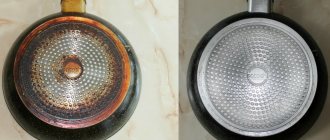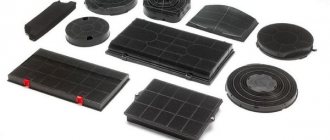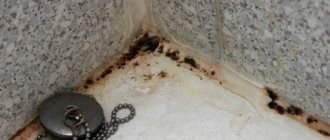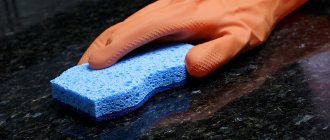Home page » Home and comfort » Cleaning
Author of the article
Svetlana Pavlikhina
Reading time: 5 minutes
AA
Kitchen products made from ceramics are environmentally friendly, look good, and are easy to use. During use, they become dirty just like other dishes. There is very little information on how to clean a ceramic frying pan.
But experienced housewives know truly effective ways.
Features of ceramics
These pans are made of aluminum and coated with a layer of ceramic inside and out. The multi-layer bottom allows you to heat food quickly without sticking.
When heated, the coating can withstand temperatures up to +450 °C, but the handle of the product remains cold.
During cooking, food does not stick to the coating, which makes cleaning much easier.
Ceramics can significantly reduce the consumption of oil and fat during cooking.
But there are some nuances in using dishes with this coating:
- she is afraid of sudden changes in temperature, microcracks appear;
- It is not recommended to wash in the dishwasher;
- The coating is not resistant to falling: it chips when hit.
Users are also confused by the high price of such dishes.
Preparation for use
After purchasing the frying pan, you need to properly prepare it for use.
The vessel is washed with warm water and dishwashing detergent and wiped with a dry, clean towel.
A brand new saucepan is placed on the stove and it is turned on. Sprinkle the bottom with a small layer of table salt; it will help heat the coating evenly. After a few minutes, the salt is poured out.
Afterwards, the surface is lubricated with vegetable oil to preserve and improve the non-stick properties of the new product. Turn off the heat and wipe the surface with a paper napkin or towel to remove all fat.
Once cooled, the pan is ready for use.
Temperature changes
During operation, one simple rule is followed: the frying pan is washed only after it has completely cooled.
Pouring cold water or dough onto a hot surface is prohibited, otherwise the coating will begin to crack and lose its non-stick properties.
Selecting cleaning products
To clean such dishes, do not use metal sponges or powders with abrasive particles . They can damage the surface and ruin its integrity.
In the process, you can get by with warm water, and use gel detergents and cleaners to break down fat.
Removing fresh carbon deposits
It is easier to get rid of recently formed burnt food residues immediately than after some time. In this case, the dishes are washed faster.
Soak
After use, allow the pan to cool down. Then it is washed with warm water, filled a third with liquid and a drop of detergent is added. The dishes are left for 20 minutes. As soon as the burnt softens, remove it with a simple kitchen sponge.
Olive oil
A soft, clean cloth is moistened with oil and wiped over the contaminated surface. If the carbon deposits are not ingrained into it, it will come off easily.
Alcohol
After deep-frying food, rust stains from burnt oil remain on the bottom and sides of the cookware. Removing them is easy if you do it immediately after cooking, after cooling the pan.
A dry cloth is moistened with alcohol and the coating is wetted until it is completely clean. Instead of medical alcohol, you can take vodka or ammonia.
Remove carbon deposits
How to properly clean a ceramic frying pan if dark spots appear on its internal surfaces:
- Wait until the cookware has cooled down after use. You should not immediately fill it with water - temperature changes may cause cracks to appear on the coating.
- Pour warm water into it and leave to soak for an hour.
- Pour dish gel onto a sponge and wipe problem areas.
We also recommend reading: How to clean a samovar at home
After that, rinse and dry. If gentle cleaning does not help, try other means.
Removing stubborn dirt
Strong carbon deposits that have formed a long time ago are quite difficult to remove. To do this, you should apply some housekeeping tricks. Homemade cleaning products can also deal with this problem.
Vinegar and citric acid
Acids will help quickly get rid of carbon deposits inside. These substances quickly corrode old grease without damaging the surface.
Fill the pan a third with water, add half a glass of vinegar or 1 tbsp. l. citric acid, stir. Place the frying pan on the stove and bring the liquid to a boil. Then let it cool.
Cold acidified water is washed off, and the carbon deposits are cleaned with a kitchen sponge and a drop of dishwashing detergent.
Frying pan eraser
A ceramic frying pan that has yellow stains on it can be easily cleaned with a school eraser.
The saucepan is filled with water with the addition of dishwashing detergent; Fairy is suitable for these purposes. The solution is left for half an hour.
After wet cleaning, proceed to dry cleaning. The frying pan is wiped with a rag, and the dark spots are removed with a rubber band.
Activated carbon
Activated carbon is an excellent absorbent, which is used not only in medical practice. Take 20–15 tablets of the black drug and grind it into a powder.
Rinse the pan with water and cover the entire bottom with dishwashing detergent. Rub the gel into an even layer, and sprinkle crushed activated carbon on top of it.
After 1 hour, rinse everything off with warm water, if necessary, rub the stain with a sponge or repeat the manipulation with the tablets.
Cleaning outside
During the cooking process, carbon deposits form on the outer walls of the pan. Not all products are suitable for its removal.
Melamine sponge
This product enjoys well-deserved popularity among modern housewives. With its use, no additional detergents or cleaning agents are required when removing carbon deposits.
The sponge is moistened with water and wrung out without twisting.
Use the edge of a swollen sponge to remove carbon deposits and other contaminants. Once the pan is completely clean, it is thoroughly washed under running water to remove any remaining melamine chips, because they are harmful to the human body.
Activated carbon
To prepare the cleaning product, take 10 tablets of activated carbon and grind them in a mortar until a powder is formed.
Wash the outside of the pan with a sponge and detergent. The still damp surface is sprinkled with the resulting black powder, left for half an hour, then the container is washed with a sponge under running water until it shines.
Cooker cleaner
Manufacturers produce such products in spray bottles. These are chemicals that contain potent components. They can only be used on the outside of the cookware.
The cleaning agent is sprayed onto the bottom and sides of the frying pan and left for a while (indicated on the label). After the procedure, the vessel is thoroughly washed under running water.
How to clean
To remove old or thick layers of carbon deposits, various compounds are used - both household chemicals and improvised means. It is advisable to resort to some methods only in the most difficult cases, since they can destroy the coating if used frequently.
Melamine sponge
Carbon deposits on the outer walls of a ceramic frying pan can be cleaned using a melamine sponge. Cleaning should be done with gloves. The sponge is moistened with water, and then the darkened areas are treated. Afterwards, rinse the product thoroughly with plenty of water.
Important! You cannot clean the inside of the frying pan with a melamine sponge - it will damage the coating. In addition, during the friction process, the smallest particles of the sponge remain on the surface and can enter the human body along with food.
Alcohol
Surfaces covered with grease can be washed with alcohol. A cotton pad is soaked in the liquid and then applied to the stain. During the process, you will have to change the disk to a new one several times.
Water, sponge and detergent
To wash a frying pan with a ceramic coating inside from dark deposits, you can apply dish gel to a sponge, rub, without pressing too hard, the areas with soot, and leave for a few minutes. During this time, the burnt fat will soften and can be washed off with water.
Fat removal gel
A radical way to clean a frying pan with a ceramic coating is to use a product with a fat splitter. There are compositions designed for ceramic-coated cookware. However, most of them contain alkali, which damages the non-stick coating. Such compositions can be used only in the most advanced cases, when others have not helped. The procedure for use is indicated by the manufacturer of a specific product on the packaging.
Digestion
To remove carbon deposits from the inside, you can boil the frying pan in a soapy solution. To do this, you will need a capacious container, ¾ filled with water. They put it on the fire, and while the water is heating up, rub ½ bar of laundry soap and grate it. Add shavings to hot water, add 140 g of soda. Mix thoroughly until the dry ingredients are completely dissolved.
We also recommend reading: Cleaning the dishwasher, detergents for dishwashers
When the water boils, lower the dirty dishes into the container and reduce the heat to low. After 90 minutes, drain the soap solution, wait for the pan to cool slightly, and then rinse with water.
Dishwasher
Dishes with a ceramic surface can be washed in the dishwasher. First, the surface is cleaned of food residues by wiping with a dry cloth, placed in the machine and the intensive cleaning mode is activated.
Grater, eraser
Small carbon stains can be wiped off with a regular eraser. The dishes must first be washed with a soapy sponge and dried with a paper towel. Then, using an eraser, they try to clean off the plaque from the internal or external surfaces.
Hydrochloric acid
In particularly serious cases, you can try to remove the outer surfaces of dishes covered with old plaque with a product containing hydrochloric acid. You can find such compositions in a hardware store, but you should use them very carefully, wearing gloves, and thoroughly rinse off any remaining product with running water.
Activated carbon
Rinse a pot or frying pan with a ceramic coating, and spread a layer of dishwashing gel over the contaminated surfaces with a sponge. 1-2 packs of coal are crushed into powder with a spoon. Sprinkle it on surfaces coated with gel and wait 60 minutes. After this period, scrub the stained areas with a sponge. Wash off with water. Repeat all steps again if some of the contamination remains.
Lemon acid
To remove burnt fat from ceramics, fill the frying pan with water and put it on fire. Pour in a packet of acid or add a little vinegar and wait until the liquid begins to boil. Immediately turn off the stove and leave to cool. When the liquid is at room temperature, it is drained, and the dishes are wiped with a sponge and rinsed.
Thick layer of soot
If a thick layer of burnt fat has formed on the surface of the frying pan and has not been cleaned off for a long time, conventional methods will not cope with it. Strong acids will come to the rescue.
Hydrochloric acid
For kitchen work, use a solution of low concentration, no more than 15%. During the cleaning process, do not allow the product to flow into the inside of the vessel.
Protective rubber gloves are first put on your hands. A kitchen sponge is generously moistened with acid. Begin the cleaning procedure: wipe the surface with a washcloth until it is completely clean.
The acid is left on the ceramic for another 15 minutes, then thoroughly washed off with detergent and rinsed several times under running water.
Digestion
Boiling is suitable for any type of pan. It copes with the task perfectly and effectively removes any contaminants.
To boil ceramic kitchen utensils you will need:
- 500 grams of baking soda;
- bar of 72% laundry soap;
- 2 bags of silicate glue.
To carry out the procedure, also prepare a large container so that the frying pan can fit into it.
Digestion algorithm:
- A sufficient amount of water is placed on the fire and heated. Add grated soap, then soda and glue. All components must be completely dissolved.
- The frying pan is placed in a boiling container, brought to a boil and left on the fire for 15 minutes. After boiling, the kitchen utensils are left in the water for another 2 hours.
- At the end of the procedure, wash the pan with a sponge.
To remove carbon deposits from ceramic dishes, you cannot use a metal scraper; it leaves scratches on the surface.
Precautionary measures
During the cleaning process, especially with aggressive acids, protective gloves are used. The windows in the room are opened so as not to breathe in harmful fumes.
Ceramics cannot be cleaned with soda - the substance destroys the fragile, protective layer with non-stick properties.
Ceramics should not be soaked for more than 30 minutes, because this leads to the appearance of microcracks.
Carbon deposits cannot be removed with a metal sponge or scraper - this will damage the non-stick coating.
Correct operation
Before first use, you need to prepare the dishes. It is worth reading the manufacturer's instructions.
Helpful Tips:
- During the frying process, be sure to add a small amount of oil.
- The diameter of the burner should not exceed the circumference of the bottom.
- The side walls of the frying pan should not be exposed to fire: they may darken.
During the cooking process, it is forbidden to use metal spatulas or scrapers; choose only silicone or wood.- To wash ceramic-coated frying pans, choose only soft foam sponges or napkins made of absorbent soft fabric.
- After each use, wash the dishes and wipe off excess moisture. This is important because the frying pan cannot be stored if drops of water remain on the surface.
- Wash with water at a temperature not exceeding +40 °C.
- Hand washing is preferable to machine washing.
- If the coating remains clean after use, it is enough to wipe it with a paper towel. This cleaning method extends the life of the ceramics.
- If cleaning takes place in a dishwasher, make sure that the water temperature does not exceed +40 °C.
When stored in a cabinet with other utensils, especially metal ones, ceramic-coated products are protected from contact with the paper or fabric layer. This helps to avoid scratches and microcracks that impair non-stick properties.











